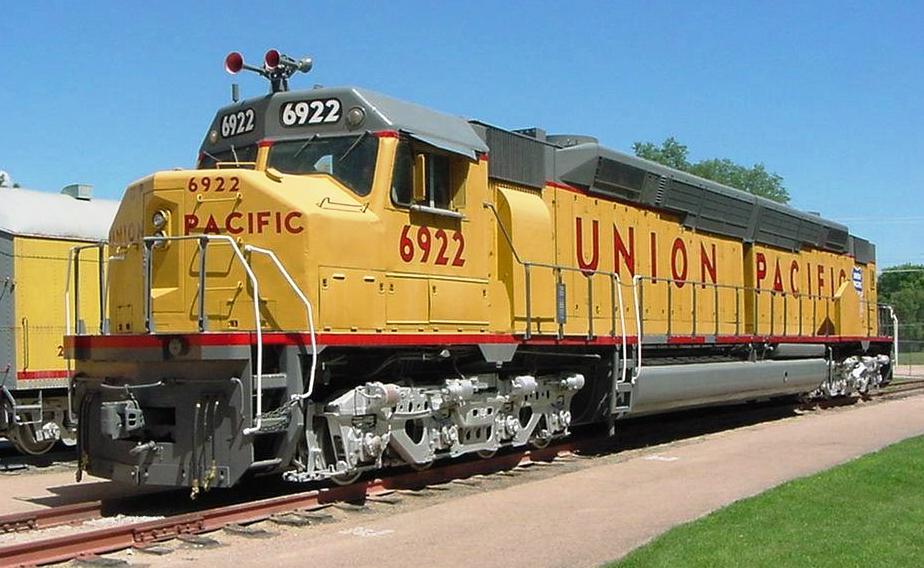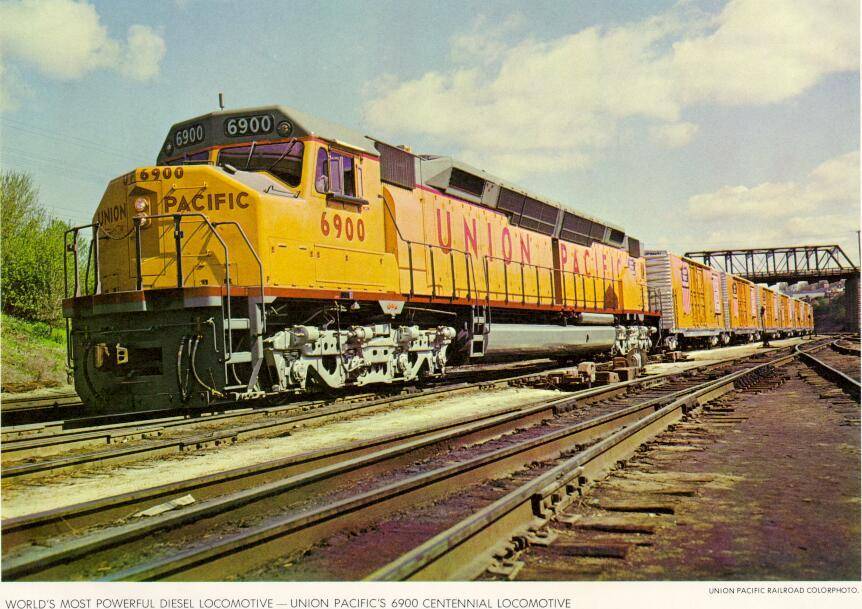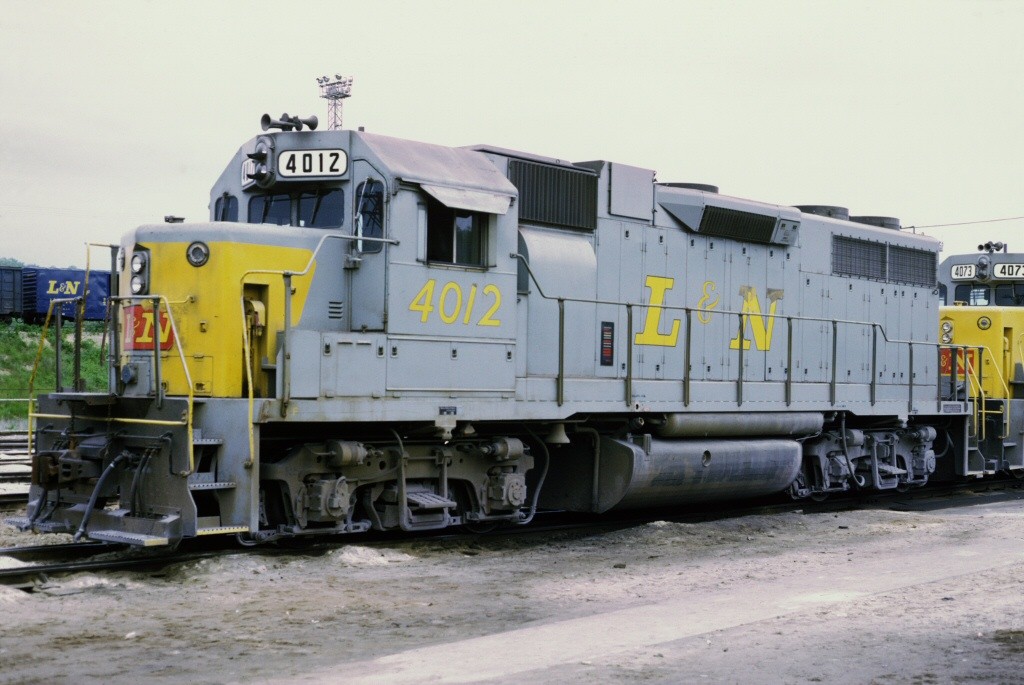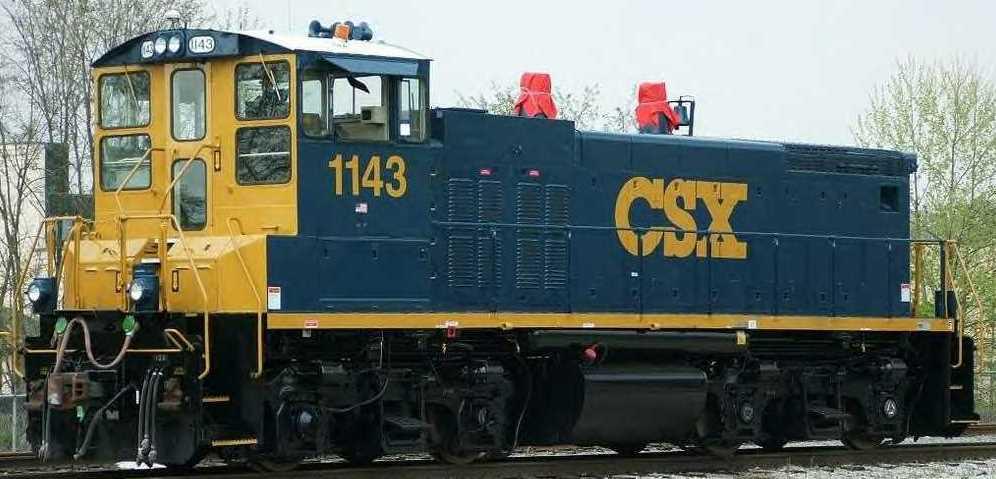History: The model designation, DDA40X (or DD40AX), comes from two D (four axle) trucks, A for a cab, 40 to indicate the use of the 16-cylinder 645E3 engine as in the GP40 and SD40, and X to indicate some experimental features. The first of the experimental features was an uprating of the 645E3 engine from 3,000-horsepower to the 645E3A engine with 3,300 horsepower. Another feature was the ability to perform a self-load test (checking that the alternator was producing power) without an external load test box to absorb the electrical power created. Next there was the usage of modular control circuits replacing considerable amounts of wiring. There was one other major difference between the Centennials and most regular freight units and that was the use of the 59:18 gear ratio that allowed 90 MPH operation instead of the standard 62:15 ratio that had a maximum of 75 miles per hour.
The DDA40X was a massive locomotive, 98 feet, 5 inches long, 17 feet four inches tall with 8,200-gallon fuel tanks and an operational weight of 545,432 pounds. They were delivered on two orders: the first order was for 25 units, numbers 6900 through 6924, delivered between April and December 1969. The second order was for 22 units, numbers 6925 through 6946, delivered between June 1970 and September 1971. Each cost $551,168.
Over the years, the Centennials underwent various modifications. The horns were originally mounted between the first and second radiator fans. Later they were moved to the cab roof. Two units were equipped with sirens as an experimental means of warning maintenance of the way personnel of the approaching train. Various types of strobe lights, flashers, and rotary beacons were installed on the DDA40Xs to make them more visible. Number 6936, still operating in UP's Heritage Fleet, was modified with exposed bearings on the trucks, air conditioning and a new nose door following a grade crossing collision on.
Thirteen examples survive, including one unit (6936) which is still in service with Union Pacific.
Read more on Wikipedia
The DDA40X was a massive locomotive, 98 feet, 5 inches long, 17 feet four inches tall with 8,200-gallon fuel tanks and an operational weight of 545,432 pounds. They were delivered on two orders: the first order was for 25 units, numbers 6900 through 6924, delivered between April and December 1969. The second order was for 22 units, numbers 6925 through 6946, delivered between June 1970 and September 1971. Each cost $551,168.
Over the years, the Centennials underwent various modifications. The horns were originally mounted between the first and second radiator fans. Later they were moved to the cab roof. Two units were equipped with sirens as an experimental means of warning maintenance of the way personnel of the approaching train. Various types of strobe lights, flashers, and rotary beacons were installed on the DDA40Xs to make them more visible. Number 6936, still operating in UP's Heritage Fleet, was modified with exposed bearings on the trucks, air conditioning and a new nose door following a grade crossing collision on.
Thirteen examples survive, including one unit (6936) which is still in service with Union Pacific.
Read more on Wikipedia
Railroad/Company: Electro-Motive Diesel (EMD) is an American manufacturer of diesel-electric locomotives, locomotive products and diesel engines for the rail industry. The company is owned by Caterpillar through its subsidiary Progress Rail Services Corporation.
Electro-Motive Diesel traces its roots to the Electro-Motive Engineering Corporation, a designer and marketer of gasoline-electric self-propelled rail cars founded in 1922 and later renamed Electro-Motive Company (EMC). In 1930, General Motors purchased Electro-Motive Company and the Winton Engine Co., combining the two to form its Electro-Motive Division (EMD) in 1941.
In 2005, GM sold EMD to Greenbriar Equity Group and Berkshire Partners, which formed Electro-Motive Diesel to facilitate the purchase. In 2010, Progress Rail Services completed the purchase of Electro-Motive Diesel from Greenbriar, Berkshire, and others.
EMD's headquarters, engineering facilities and parts manufacturing operations are based in McCook, Illinois, while its final locomotive assembly line is located in Muncie, Indiana. EMD also operates a traction motor maintenance, rebuild and overhaul facility in San Luis Potosí, Mexico.
As of 2008, EMD employed approximately 3,260 people, and in 2010 it held approximately 30 percent of the market for diesel-electric locomotives in North America.
From Wikipedia
Electro-Motive Diesel traces its roots to the Electro-Motive Engineering Corporation, a designer and marketer of gasoline-electric self-propelled rail cars founded in 1922 and later renamed Electro-Motive Company (EMC). In 1930, General Motors purchased Electro-Motive Company and the Winton Engine Co., combining the two to form its Electro-Motive Division (EMD) in 1941.
In 2005, GM sold EMD to Greenbriar Equity Group and Berkshire Partners, which formed Electro-Motive Diesel to facilitate the purchase. In 2010, Progress Rail Services completed the purchase of Electro-Motive Diesel from Greenbriar, Berkshire, and others.
EMD's headquarters, engineering facilities and parts manufacturing operations are based in McCook, Illinois, while its final locomotive assembly line is located in Muncie, Indiana. EMD also operates a traction motor maintenance, rebuild and overhaul facility in San Luis Potosí, Mexico.
As of 2008, EMD employed approximately 3,260 people, and in 2010 it held approximately 30 percent of the market for diesel-electric locomotives in North America.
From Wikipedia
Item Links: We found: 1 different collections associated with Rail - Locomotive - EMD DDA40X
- Collection N Scale Model Trains: 16 different items.
Item created by: Alain LM on 2018-03-30 13:25:40. Last edited by Alain LM on 2018-04-07 04:23:07
If you see errors or missing data in this entry, please feel free to log in and edit it. Anyone with a Gmail account can log in instantly.
If you see errors or missing data in this entry, please feel free to log in and edit it. Anyone with a Gmail account can log in instantly.










